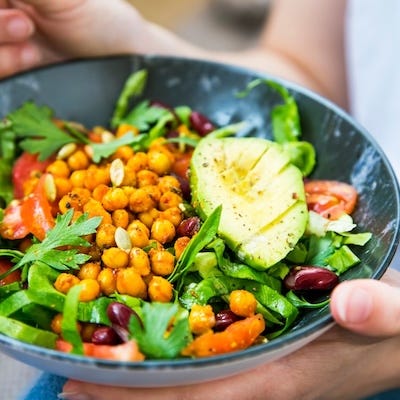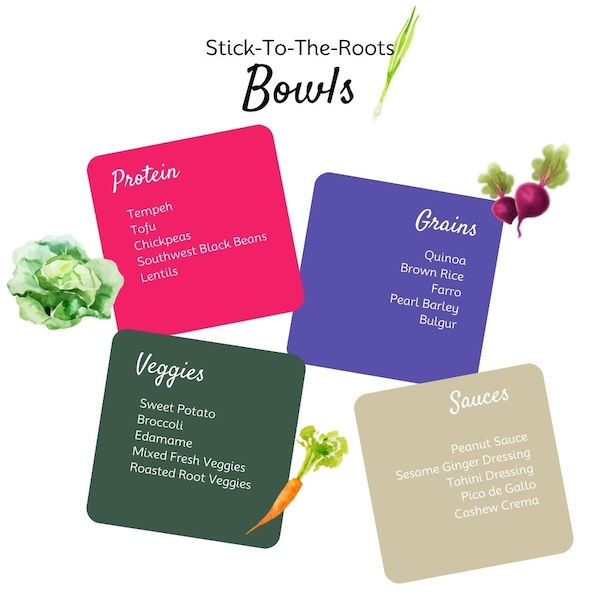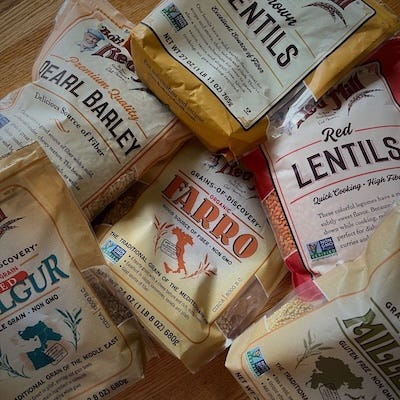How do you stick to plant-based eating when you’re at home, hungry, and have no idea what to cook?
These are the times when nothing will do but a “bowl.” They’re easy to create. You can plan them in advance. And frankly, you can’t go wrong once you start eating bowls regularly.
I first came across this idea years ago when I was introduced to the concept of a Buddha bowl.
Think of a Buddha bowl as balanced eating. You take a little of several things that are good for you, combine them in a bowl, and start eating. Start with a grain. Add protein (vegan style). Throw on a few veggies. Add a yummy sauce. And voila, you have a fast, good-for-you meal.
I love this concept! It works as well for dinner as it does for lunch. Make larger batches from each category, and you have fast, grab-and-go food that works well whenever you’re in a hurry.
Isn’t that when you fail the most? I know that’s the hardest time for me, peering into the fridge and wondering what I’m going to make. If part of the meal is sitting there waiting for you, it takes away the questions. You grab, combine, and dig in!
Let’s start with protein
Yes, you can get protein from things other than animal products. It’s one of the most common questions I’m asked.
Love beans? They’re a great place to start. Kidney beans, white beans, fava beans, pinto beans, black beans - they all can make a great addition to your bowls.
Want to try something new? If you haven’t cooked with tempeh yet, I’d suggest starting there.
Tempeh is a good way to get B vitamins, fiber, iron, calcium, and other minerals. It has isoflavones, which have cancer-fighting and antioxidant properties. It’s made from fermented soybeans; fermented foods are great for gut health.
I’m also a big fan of tofu. I like it crispy with just a hint of flavor. Here’s what I do:
Crispy Baked Tofu
14 ounces extra-firm tofu, pressed, patted dried, and cubed
2 tablespoons tamari
1 tablespoon extra-virgin olive oil
Salt and pepper, to taste
1 tablespoon cornstarch
Directions:
Press the tofu to remove some of the moisture, then pat dry.
Mix olive oil, tamari, and salt and pepper in a bowl. Add cubed tofu and toss.
Sprinkle cornstarch and toss to coat.
Spread tofu evenly onto a parchment-lined baking sheet. Bake at 425°F for 25 minutes, or until browned on the edges.
As you get more comfortable building your bowls, you’ll also find many ways to create your protein items and have a few extras in the fridge. I love tossing a few different kinds of protein together and adding them to my bowls. Tempeh and chickpeas? You bet. Tofu and lentils? I love ‘em! Even several beans together can make a satisfying bowl.
Throw in some grain
What does grain look like in your life? I remember back when I was first trying to decipher all of this, rice was my go-to grain. And it usually came in a box - hello, Rice-a-Roni. Or instant rice.
It’s time to think differently about grain. And to do that, let’s head out into the fields where they grow.
We’ve been led to believe that grains are bad. Not true. In fact, they are the cornerstone of good eating. The problem is what we’re doing to them.
Whole grains (unprocessed) are filled with healthy vitamins, minerals, fiber, carbohydrates, protein, and healthy unsaturated fats. Processing them removes the fiber-rich outer layer. Milling them removes the germ layer, which contains essential fatty acids and vitamins.
It’s easy to assume that whole grains are better than processed, and that’s true. It’s where you start when selecting grains to bring into your diet.
But it goes deeper than that.
It’s how we grow them, how we nurture them, and how we harvest them. This isn’t a post on glyphosate, (I’ll get into that in another post), but glyphosate was introduced into our food supply in 1996, and it’s now impossible to avoid. It’s in our food, water, air, personal care products, and our bodies. And it’s impacting our health.
As you select grains for your bowls, start with organic grains. Organic grain ensures the cleanest, healthiest ingredients possible on this planet today. Is it glyphosate-free? That isn’t easy to find after we’ve sprayed glyphosate on so much worldwide. But it’s your best choice for the healthiest grain available today.
Look for grains beyond your standard rice. Brown rice is a good choice, but expand your palate from there.
I eat quinoa regularly and like its consistency. Farro has a slightly nutty grain flavor I’m addicted to. I love throwing it in bowls or on top of arugula for a rich and hearty experience. Barley is a bit more chewy with a nutty aftertaste. It works well in casseroles and salads, too. You’ll often find bulgur in tabbouleh and pilafs. It’s a smoother, chewier texture than others. I fell in love with it in a cantaloupe salad I had at a potluck many years ago, and recreate it regularly for my meals. It’s one of my go-to picnic meals in the summer.
I live just a few miles from Bob’s Red Mill, and visit there regularly to buy their grains in bulk. I’ve found them globally, so they’re an easy brand you can rely on for good food. There are many others - just focus in on the ingredient list.
With any grain you make, double your recipe. That gives you a bowl full in the fridge you can use throughout the week as you quickly put your salads and bowls together.
Add in the veggies
There really isn’t a wrong way to add veggies into your bowls. The key here is to experiment with many different kinds of veggies, the more colorful the better.
I’m a huge proponent of shopping at farmer's markets. This is an easy way to shop what’s in season, and give your meals a little variety.
In the heart of winter, you’ll find root vegetables galore. Pick some up:
Roasted Root Veggies
Sweet potatoes
Carrots
Beets
Onions
Parsnips
Rutabaga
Winter squash
Directions:
Cut them into 1-inch, bite-sized pieces. Toss them in a little olive oil, add a little salt and pepper, and bake for 45 minutes in a 400°F oven, or until tender.
You can’t go wrong with whatever you find in your local market. Try this out for size:
Mixed Fresh Veggies
Small yellow onion, diced
Medium zucchini, diced
Small red pepper, diced
2 Roma tomatoes, diced
1 ear of corn, sliced from the cob
3 garlic cloves, minced
Olive oil
½ teaspoon oregano
½ teaspoon cumin
Salt and pepper, to taste
Handful of fresh cilantro, chopped
Directions:
Heat a tablespoon of olive oil over medium heat. Add onion and saute until tender and translucent. Add red pepper, zucchini, tomatoes, corn, and garlic and saute, stirring occasionally, until tender, about 5 minutes. Add oregano, cumin, salt and pepper, and cook for 2 minutes. Stir in cilantro and serve immediately, or store in the fridge for up to 4 days.
Are you starting to see the possibilities? When in doubt, throw in a handful of your favorites. I love radishes - have you tried watermelon radishes? Or easter egg radishes? How about a handful of snap peas, green beans, or asparagus? Sometimes raw is even better than cooked, especially if you have a yummy sauce as a topper.
It’s the sauce that adds pizazz
In my cookbook library, I have an entire cookbook dedicated to sauces. They’re that important.
Quite honestly, the biggest mistake you can make with plant-based food is to skimp on the sauces. I marinate tofu and tempeh, whip up cremas for sides, and create sauces for everything I cook. More is better - you can’t have enough sauce, herbs, and spices to add flavor to your meals.
If you get good at any one thing, I would suggest studying sauces. When you start learning how flavors come together, it truly changes the way you create your meals.
And bowls are a great place to experiment! Here are some of my favs:
Peanut Sauce
¼ cup peanut butter
2 garlic cloves, minced
1 tablespoon tamari
1 tablespoon maple syrup
1 tablespoon rice vinegar
3 tablespoons water
1-inch piece of ginger, minced
Directions:
In a bowl, whisk all ingredients until well combined. Feel free to use other nut butter as a replacement. Don’t have maple syrup? Agave works just fine.
Tahini Sauce
¼ cup tahini
1 garlic clove, minced
2 tablespoons lemon juice
2 tablespoons maple syrup
2 tablespoons water
Salt and pepper, to taste
Directions:
In a bowl, whisk all ingredients until well combined.
Cashew Crema
1 cup cashews, soaked and drained
2 tablespoons lemon juice
½ cup water
½ teaspoon salt
Directions:
Soak cashews overnight in water to soften. Drain. Add cashews, lemon juice, water, and salt into a high-speed blender. Blend until smooth. Add enough water to get the desired consistency.
Are you ready to try a bowl? What’s your favorite? I’d love to hear how you add this to your plant-based kitchen.








